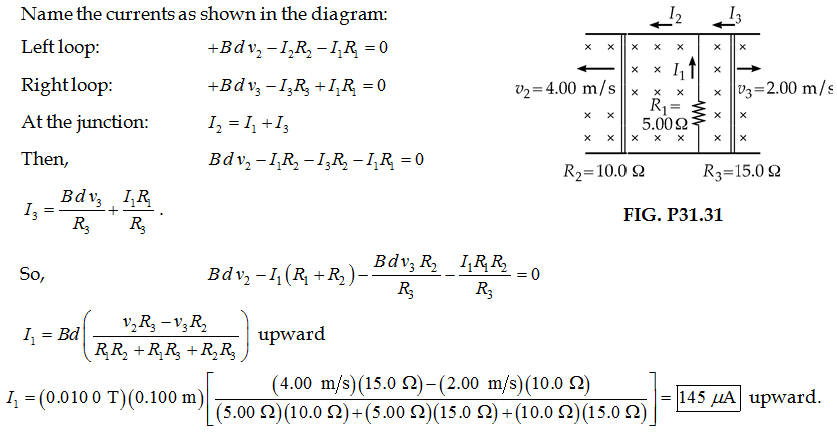Summary
- Fields exert forces on currents
- Charged particles in a magnetic field
- Force between parallel wires
- Solenoids
Chapter 23

- EMF induced in a moving conductor applet
Example #1
Example #2
Example #3
Example #4
Example #5
- the ill-fated
STS-75 Tethered Satellite System
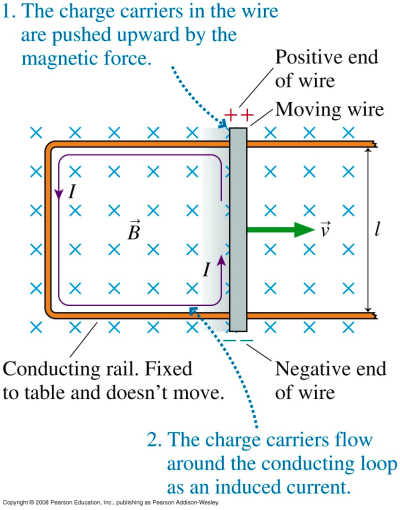
- Magnetic flux applet and equation
Example #6
- Lecture learning outcomes
A student who masters the topics in this lecture will be able to:
- predict the polarity of the electromotive force (emf) that appears in a conductor that moves through a magnetic field
- use algebra to find the emf ℰ, magnetic field B, velocity v, or perpendicular length ℓ when any three of these quantities are given
- describe the concept of magnetic flux and identify the orientations of a loop in a uniform magnetic field that produce zero flux, maximum flux, and intermediate flux.
- use algebra to find the magnetic flux Φ, magnetic field B, area A, or orientation angle θ when any three of these quantities are given
Practice:
Try these additional examples
Example #7
Example #8
(Challenging!) Example #9
Prepare:
Read textbook sections 23-3 and 23-4 before the next lecture
POP4 23.13
A 1.2-m frictionless bar slides at 2.0 m/s in a 2.50-T magnetic field as shown. If R = 6.0 Ω,
what current flows in the circuit?

A. 0.417 A
B. 0.833 A
C. 1.00 A
D. 2.50 A
Answer
POP4 23.13
A 1.2-m frictionless bar slides in a 2.50-T magnetic field as shown. If R = 6.0 Ω,
what force is needed to keep the bar sliding at 2.0 m/s?

A. 3.00 N
B. 1.00 N
C. 0.500 N
D. 0.025 N
Answer
POP4 23.13
A 1.2-m frictionless bar slides at 2.0 m/s in a 2.50-T magnetic field as shown. At what rate is mechanical energy delivered to the bar?

A. 1.50 W
B. 6.00 W
C. 12.0 W
D. 36.0 W
Answer
POP4 23.13
At what rate is energy delivered to the resistor?

A. 1.00 W
B. 3.00 W
C. 6.00 W
D. 10.0 W
Answer
POP4 22.62
The figure shows an electromagnetic blood flowmeter. If the vessel diameter is 3.00 mm,
B = 0.0400 T, and ε = 160 µV, what is the speed of the blood?
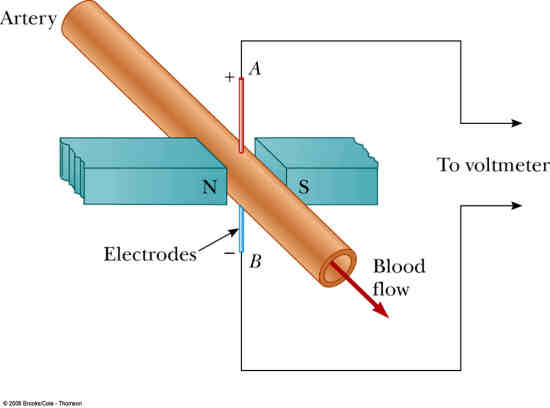
A. 0.625 m/s
B. 1.33 m/s
C. 0.750 m/s
D. 4.87 m/s
Answer
Walker4 23.04
Find the magnetic flux through the floor of a house that measures 22 m by 18 m. The Earth's magnetic
field at the house has a horizontal component 2.6×10−5 T north and
a vertical component 4.2×10−5 T downward.
A. 396 T·m2
B. 4.2×10−5 T·m2
C. 0.0103 T·m2
D. 0.0166 T·m2
Answer
Walker4 23.37
The Boeing KC-135R Stratotanker has a wingspan of 39.9 m and flies through Earth's magnetic field at
a location where the vertical component is 4.70×10−5 T. If the plane cruises
at 237 m/s in level flight, what emf will appear between its wingtips?

A. 535 V
B. 1.87 mV
C. 3.36 V
D. 0.444 V
Answer
Walker5e 23.40
If 8.9 W of mechanical power is supplied to the bar in the figure, and R = 22 Ω, what is the current in the circuit?

A. 1.00 A
B. 1.57 A
C. 0.636 A
D. 0.405 A
Answer
PSE6 31.31
Two parallel rails with negligible resistance are 10.0 cm apart. As the rods in the figure below are
pulled away at the rates shown in a 0.0100 T magnetic field, what is
the current through the 5.00-Ω resistor?
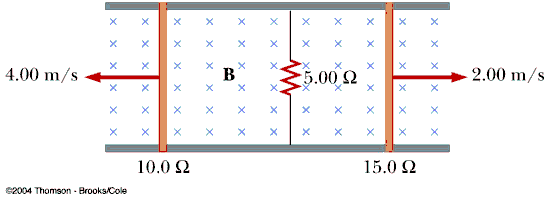
A. 145 µA
B. 22.5 mA
C. 855 mA
D. 1.75 A
Answer
C. 1.00 A

A. 3.00 N
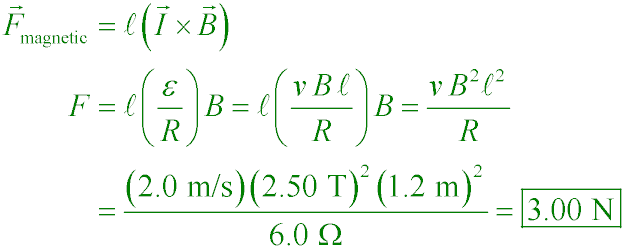
B. 6.00 W
Pmech = F×v = (3.0 N)(2.0 m/s) = 6.00 W
C. 6.00 W

Notice this is the same as the mechanical
power supplied to the bar:
Pmech = F×v = (3.0 N)(2.0 m/s) = 6.00 W
B. 1.33 m/s

D. 0.0166 T·m2
Only the downward component of the magnetic field has a component
that passes through the area of the floor (or, in other words, has a component parallel to the area
vector of the floor).

D. 0.444 V

C. 0.636 A
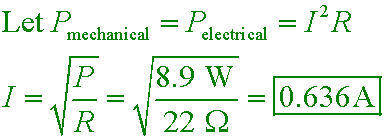
The mechanical power supplied to the bar equals the electrical power in the circuit (conservation of energy). The electrical power in the circuit is connected to the current and the resistance as shown. Alternatively, one can set the mechanical power to F×v and substitute expressions for F and v, but the solution is much longer and arrives at the same answer.
A. 145 µA
This is a tough problem because there are two current loops,
and each sliding rail acts like a battery (a source of emf). So there's no way to avoid using
Kirchhoff's laws:
